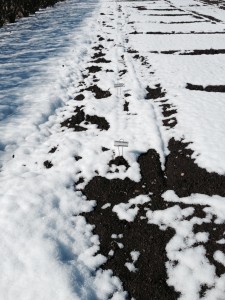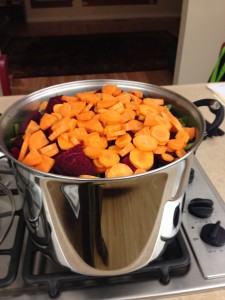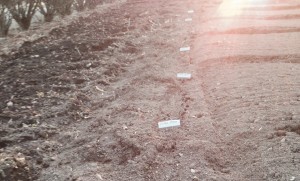On March 11th, I sowed my early season vegetables: onion, red beet, and carrot seeds (one of the first things I learned in the seed business: “You sow seed, and you plant plants,” so I always make sure to use the right phrase!).
During this very cold winter I thought that this day might never come! Surprisingly, here in zone 5, this year’s sowing is as early as I can remember. I’m lucky to have sandy soil which is well drained. In my past gardens, where I had clay soils, I couldn’t have worked the soil this early.
Carrots are always a part of my early spring harvest. I love them! This year, I tried the Yaya carrot, which has received much acclaim for its flavor. I’m anxious to see how it grows and to compare its flavor to my favorite, Envy. Year after year, I find Envy to be the all around best carrot. It has large tapered roots, a sweet flavor (for a carrot!), and a crisp texture.

It snowed a few days after my first sow – but these early season vegetables didn’t mind this snow a bit!
Last year, I grew some Danvers Half Long carrots for comparison to Envy. Danvers Half Long is an old, established variety that most gardeners have probably grown at some point. I used to think it was a pretty good carrot – before I found Envy! I peeled, sliced, blanched, and froze the Danvers Half Long carrots for use in my favorite all-vegetable soup. In December, I made a batch of soup using some of the Envy carrots that I had frozen in the 2012 season. In January, I used the first of the Danvers Half Long’s in a new batch of soup. It just didn’t taste as good as previous soups! It occurred to me that the bitter edge coming from the Danvers carrots might have given the soup its less-than-great flavor. On the next soup batch I used only Envy carrots and everything went back to tasting the way it should.
I will continue to experiment with varieties that sound good and are new to me, but Envy will be my main crop until I find something better. Maybe this year’s trial of Yaya will be the variety that will “de-throne” Envy!
Along with my beloved carrots, I also planted Harrier beets and Globo and Cortland onions. The Harrier is my favorite red beet, by far! Its rich buttery flavor puts it in a class by itself. I’ve been too busy, in recent years, to sow onion seed, so both the Cortland and Globo onions are new to me. I’m trying Globo because it is known to produce large, “lunker-size” onions. Big produce is always fun to show to friends and relatives! I chose Cortland because it was breed to store well – plus, it is resistant to diseases.
Small seeds, like onion and carrot, will germinate at a much higher rate when covered with worm castings than when covered with soil, especially if you have clay soil – plus, seedlings get a non-burning “fertilizer boost” right when they emerge. I used them on my carrots and onions, with much success. Simply make a shallow furrow for row, and cover with castings, no soil required!


